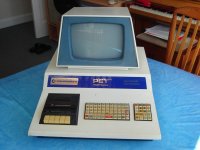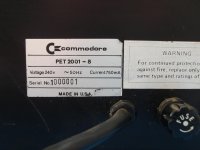I bought this Pet 2001 in 1979 when I was an engineering student. It wasn't new when I bought it. I posted here about it a few years ago then put it back in the loft, I've got it out again and I'm determined to do something useful with it.
The interesting thing about it is the serial number. It's 1000001.
I'm not sure what the significance of the number is but I have an idea the 120 volt PETs are serial number 0xxxxxx and 240 volt PETs are serial number 1xxxxxx. Can anybody confirm this ?
So does that make me the owner of Europe's first ever Personal Computer ? Is it worth a fortune, I doubt it, but perhaps it should be in a museum or a collection.
I've attached a couple of pictures. Sadly it doesn't work, the screen lights up and fills with random characters. I've tried reseating the memory but nothing changed.
I'm in the UK, just SW of London.
Any ideas what I should do with it better than putting it back in the loft ???
The interesting thing about it is the serial number. It's 1000001.
I'm not sure what the significance of the number is but I have an idea the 120 volt PETs are serial number 0xxxxxx and 240 volt PETs are serial number 1xxxxxx. Can anybody confirm this ?
So does that make me the owner of Europe's first ever Personal Computer ? Is it worth a fortune, I doubt it, but perhaps it should be in a museum or a collection.
I've attached a couple of pictures. Sadly it doesn't work, the screen lights up and fills with random characters. I've tried reseating the memory but nothing changed.
I'm in the UK, just SW of London.
Any ideas what I should do with it better than putting it back in the loft ???


